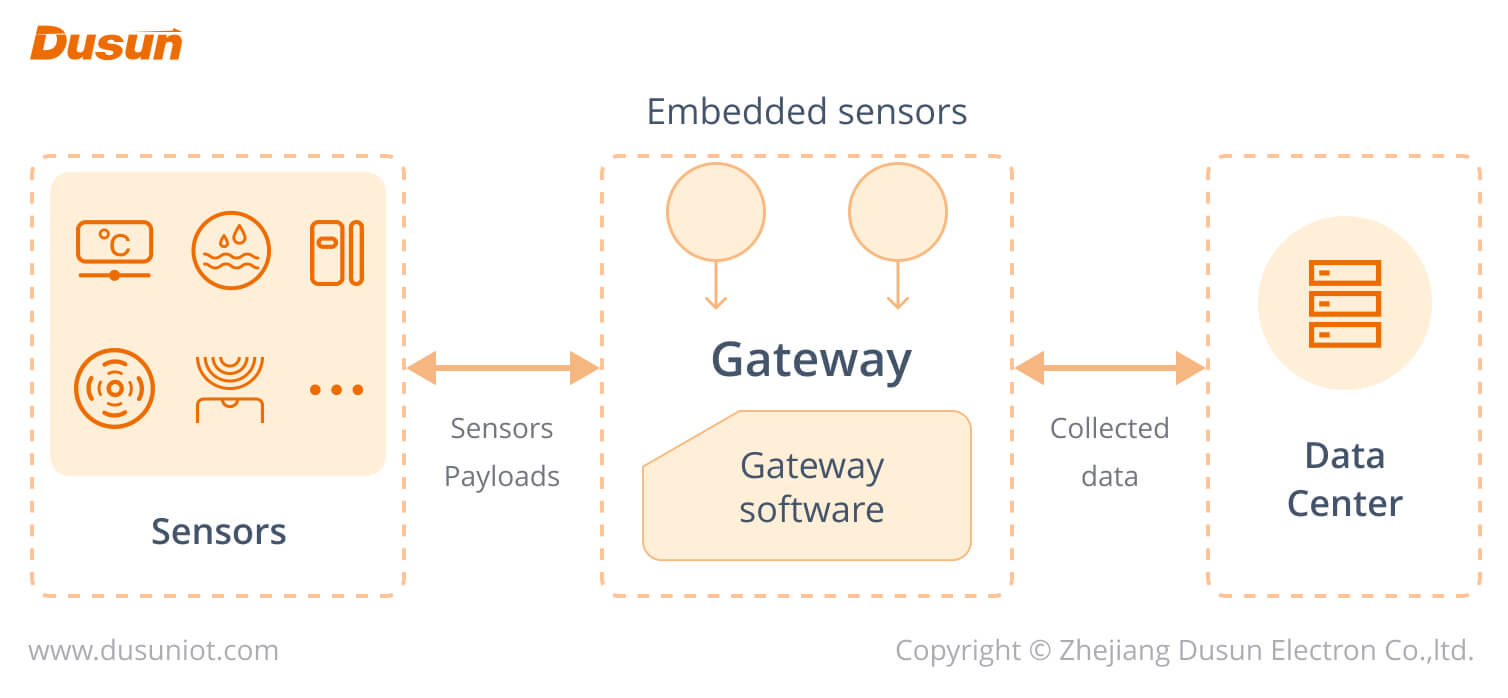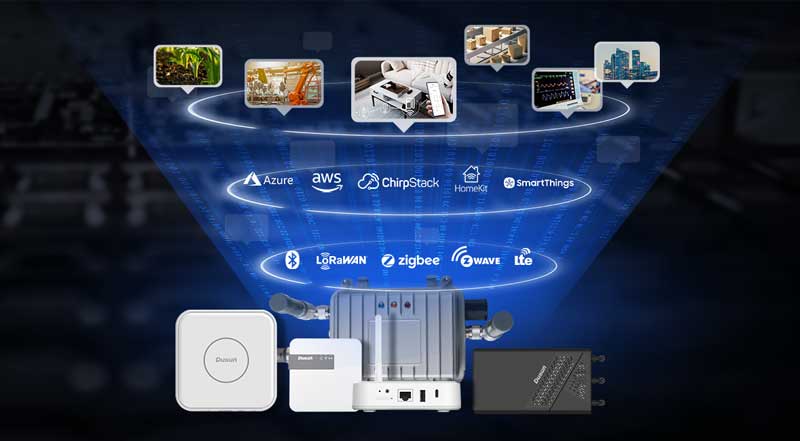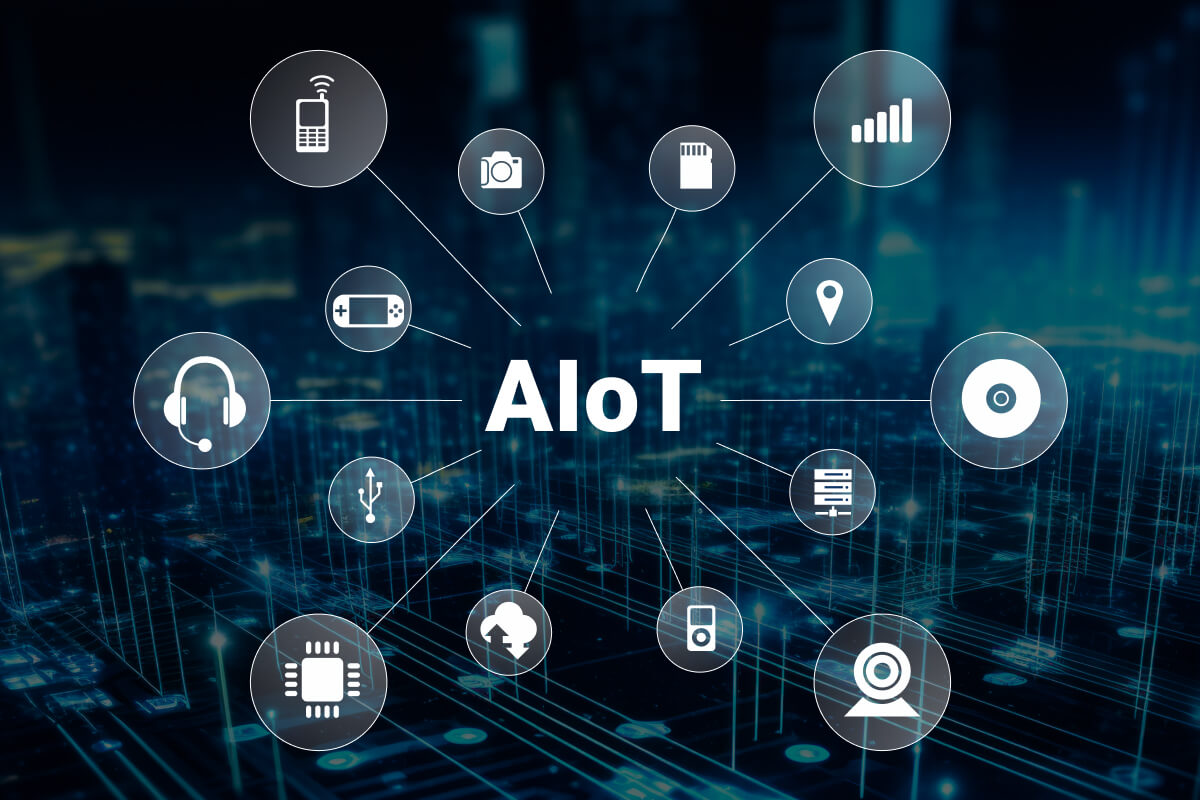When creating an IoT solution for home automation using IoT, IoT retail solutions, industrial 4.0 solutions, etc., you need to know how many devices the smart gateways can connect to make the network reliable and deliver the required performance.
This data is critical for IoT project budget planning and client-costing purposes because a setup with multiple end nodes might need more IoT gateways, resulting in a higher deployment cost. Therefore, it is important to understand the limits of each gateway, and we will answer this question below. But first, let’s look at the architecture of the IoT network.
Basic IoT Network Architecture Composed of Gateway Hubs and Sub Devices
When answering the question, “how many sub devices can a gateway connect?”, we’d better firstly focus on the connection between the sensing layer devices (sub devices) and the concentrator/edge processing functions of the gateway in the data processing layer via the wireless network layer protocols. Below is a basic IoT network architecture.

Sensing Layer
This layer is responsible for collecting data from the environment, providing some level of user interaction, and implementing feedback from the user or the upper layers. It contains all the sub devices (smart sensors, smart plugs, BLE beacons, access control panels, etc.) which are often low-powered and run on coin batteries to reduce their cost and ease maintenance.
Network Layer
The sensing layer devices or IoT devices communicate with the concentrator wirelessly and these wireless communication protocols form the network layer.
The most commonly used wireless communication protocols to interface with the end nodes are BLE, Zigbee, LoRaWAN, and Z-Wave. These low-energy IoT wireless technologies are energy efficient but transmit data at slow speeds. These speeds are okay for most IoT applications like smart homes, offices, and buildings because the sensing layer devices send data at determined intervals, not throughout.

But it is necessary to have faster wireless communication using protocols like Wi-Fi to connect sub devices that require higher transmission speeds like cameras to the smart hub gateways.
Once connected, these devices exchange data using messaging protocols like MQTT, CoAP, and HTTP.
Data Processing Layer
This layer can be split into two sections.
IoT Concentrator/Edge Processing
The gateway is the central communication device that handles the end nodes in the IoT network and bridges them to the cloud in the external network (WAN). This device handles edge processing and analytics, and it can also incorporate AI processing.
Its purpose is to filter out irrelevant or unusable data before forwarding it to the cloud for analytics processing. Edge computing gateways can also provide automation when programmed and calibrated.
Cloud Analytics
With more processing power than the gateway, the cloud extracts meaningful information from the incoming sensor data to provide meaningful insights to help in decision making.
Application Layer
The application layer is the one that interacts with the user, providing user-friendly interfaces to present the cloud analytics and control functions that send instructions down to the sub devices.
What Influences the Number of Connected Devices That a IoT Gateway Can Handle?
All smart gateways can handle different numbers of sub devices that are determined by the following factors.
Network Capacity and Bandwidth
Network capacity and bandwidth go hand in hand. Capacity refers to the network speed or how fast data can move in the network. On the other hand, bandwidth refers to the maximum data the network can handle.
IoT sub devices with local controllers process most of the data locally, meaning they reduce the bandwidth percentage they consume in the network. Therefore, a gateway in such a network can handle more end nodes than if they lacked microcontrollers.
This factor introduces another variable known as throughput, which defines how much data transfers successfully through the network. Therefore, if the end nodes send large packets of data frequently, the gateway can only handle a few of them with acknowledgement.
IoT gateways have a feature called channels, which refers to the communication pathways for data transfer to the sub devices.
Let’s say you have an 8-channel LoRaWAN gateway that can handle 1.5 million packets daily. If each end node sends and receives 100 packets per hour, the gateway can handle 1,500,000/(100×24), which is 625 devices.
With local processing, the devices might only send and receive 10 packets per hour, making the gateway capable of handling 6,250 devices.
Another thing. If the packet or payload size is too big, the gateway must be capable of creating a network with a higher bandwidth to accommodate these devices. And the more the packets they send per second or minute, the higher the capacity or speed you need in the network. Otherwise, the network will lag.
Communication Protocols
As stated earlier, sub devices and gateways communicate via protocols like ZigBee, BLE, Z-Wave, and LoRaWAN.
ZigBee is the most preferred protocol for home automation, smart retail, and other similar IoT solutions because these gateways can handle up to 65,535 devices in a mesh topology. But the protocol can only handle 21 in a star network and 421 in a tree topology.
On the other hand, a single BLE gateway can only handle 10-100 devices but this increases to about 32,000 in a mesh, which is still less than half of what ZigBee can accommodate.
Z-Wave is proprietary technology, so it is not as widespread as the other two. Also, unlike the other two, the protocol uses sub-1 GHz bands. These vary from 856-921MHz depending on the region and the protocol can handle smaller mesh networks that have up to 232 devices.
Although LoRaWAN is a low power communication protocol, it allows long range communication with a range of 3 miles in urban areas and 10 miles in rural areas.
Do you Wanna a Gateway Have All Above Protocols Together?
With LoRaWAN, there is no specific limit to the number of sub devices the gateway can connect. This number depends on the network capacity, bandwidth, and the processing capabilities of the network server and gateway. Some LoRaWAN IoT networks currently in existence have tens of thousands of sub devices connected to one gateway.
LoRaWAN implements a Time Division Multiple Access (TDMA) scheme to manage the devices, which allows time efficient sharing of the gateway’s resources between the linked devices. The protocol also distributes the devices into different classes (A, B, and C), each with different requirements and patterns.
Therefore, with careful planning and optimization, you can build a large LoRaWAN network with thousands of sub devices.

Gateway and Network Server’s Processing Capabilities
Smarter and more powerful gateways with features like AI processing are capable of handling more sub devices because their bandwidth, speed, and throughput are effectively higher.
The network server’s processing capabilities also determine this sub device connection number. For instance, a LoRaWAN network server manages sub device connectivity and registration. It also ensures the end nodes efficiently utilize the gateway’s resources by scheduling data transmission slots and downlink message distribution to each device.
Therefore, the higher the processing capabilities of these two devices, the more efficient the network will be and the more the sub devices it will handle.
External Factors
Physical obstructions like buildings, environmental factors like humidity and temperature, and interference from other wireless devices like Wi-Fi routers can impact signal propagation in the IoT network. These factors negatively affect the gateway’s capacity, meaning it can connect to fewer sub devices.
Gateway Software and Firmware
Software and firmware updates make gateways operate more efficiently, which translates to handling more devices.
Is It Better To Have the Maximum Connected Devices Possible the Gateway Can Handle?
Rarely will you find an IoT network with the sub devices at or nearing the gateway’s maximum limit because these performance figures are theoretical. The ideal does not happen in the real world because of issues like losses.
For instance, a LoRaWAN network is only 18% efficient when fully utilized. That is a whopping 82% loss or 82 packets out of every 100 lost during transmission. This efficiency will be much lower if the system includes message acknowledgements to the end nodes.
On ZigBee and BLE, the two operate in the crowded 2.4GHz frequency band, which compounds the losses issue if you have Wi-Fi in the same space.
Therefore, it is better to have fewer connected devices than the maximum possible number the gateway can handle to maintain network performance and reliable data/packet transmission from the sensor to the cloud/network server and back.
Another critical issue to consider is battery life, especially in the gateway. The more the devices the gateway connects to and communicates with, the higher the power consumption even when using low power protocols like ZigBee.
A mesh network can help shorten the data route and improve communication efficiency but remember, all communication ultimately goes through the gateway to the cloud and back. Introducing more gateways to lessen the inbound and outbound load is the best solution.
Takeaway
Instead of considering the ideal or theoretical values when determining the maximum number of devices to assign to a gateway, you should look at the real values because of transmission losses.
The goal is to make your smart IoT solutions perform better with a high level of reliability, and this might involve testing each solution to determine the maximum limit that gives the best value to your customers.
That’s it for this article! Please let us know your thoughts and sentiments in the comments below and remember to share it if you found the content insightful. See you in the next one.
















